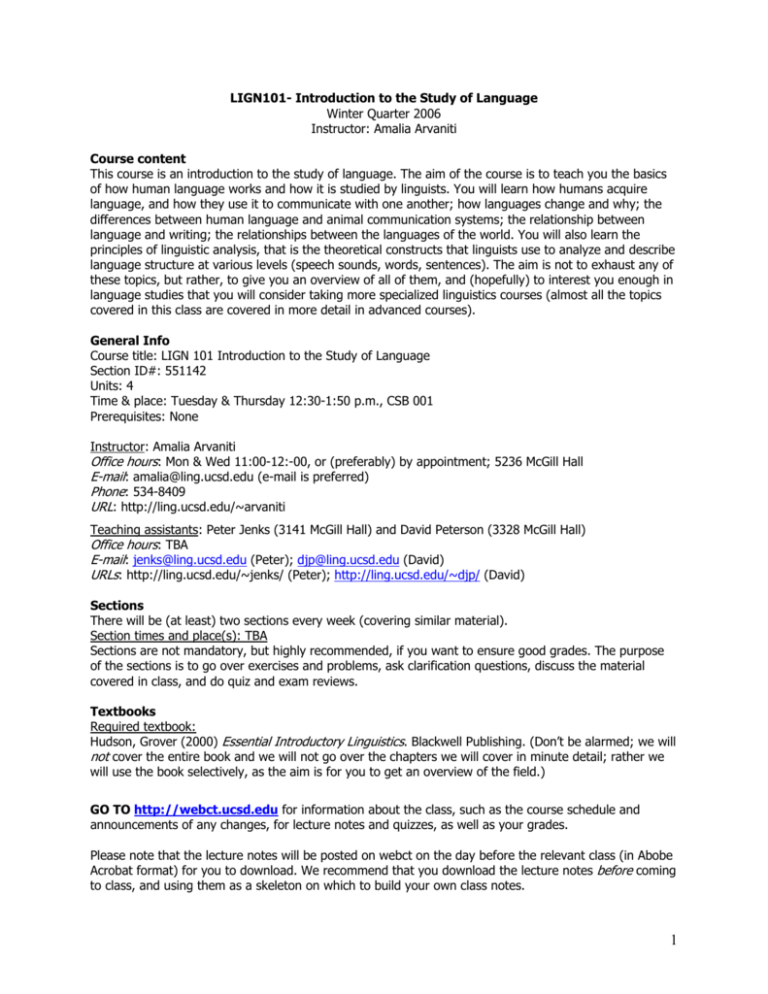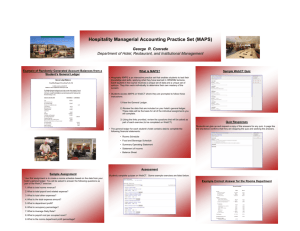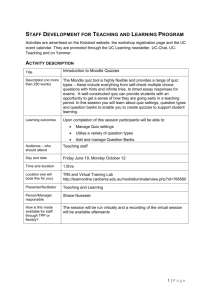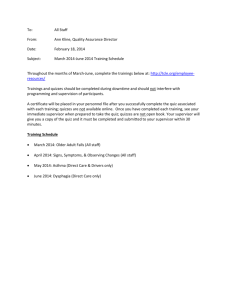the information in this website
advertisement

LIGN101- Introduction to the Study of Language Winter Quarter 2006 Instructor: Amalia Arvaniti Course content This course is an introduction to the study of language. The aim of the course is to teach you the basics of how human language works and how it is studied by linguists. You will learn how humans acquire language, and how they use it to communicate with one another; how languages change and why; the differences between human language and animal communication systems; the relationship between language and writing; the relationships between the languages of the world. You will also learn the principles of linguistic analysis, that is the theoretical constructs that linguists use to analyze and describe language structure at various levels (speech sounds, words, sentences). The aim is not to exhaust any of these topics, but rather, to give you an overview of all of them, and (hopefully) to interest you enough in language studies that you will consider taking more specialized linguistics courses (almost all the topics covered in this class are covered in more detail in advanced courses). General Info Course title: LIGN 101 Introduction to the Study of Language Section ID#: 551142 Units: 4 Time & place: Tuesday & Thursday 12:30-1:50 p.m., CSB 001 Prerequisites: None Instructor: Amalia Arvaniti Office hours: Mon & Wed 11:00-12:-00, or (preferably) by appointment; 5236 McGill Hall E-mail: amalia@ling.ucsd.edu (e-mail is preferred) Phone: 534-8409 URL: http://ling.ucsd.edu/~arvaniti Teaching assistants: Peter Jenks (3141 McGill Hall) and David Peterson (3328 McGill Hall) Office hours: TBA E-mail: jenks@ling.ucsd.edu (Peter); djp@ling.ucsd.edu (David) URLs: http://ling.ucsd.edu/~jenks/ (Peter); http://ling.ucsd.edu/~djp/ (David) Sections There will be (at least) two sections every week (covering similar material). Section times and place(s): TBA Sections are not mandatory, but highly recommended, if you want to ensure good grades. The purpose of the sections is to go over exercises and problems, ask clarification questions, discuss the material covered in class, and do quiz and exam reviews. Textbooks Required textbook: Hudson, Grover (2000) Essential Introductory Linguistics. Blackwell Publishing. (Don’t be alarmed; we will not cover the entire book and we will not go over the chapters we will cover in minute detail; rather we will use the book selectively, as the aim is for you to get an overview of the field.) GO TO http://webct.ucsd.edu for information about the class, such as the course schedule and announcements of any changes, for lecture notes and quizzes, as well as your grades. Please note that the lecture notes will be posted on webct on the day before the relevant class (in Abobe Acrobat format) for you to download. We recommend that you download the lecture notes before coming to class, and using them as a skeleton on which to build your own class notes. 1 Requirements and grading • This course involves a fair amount of memorizing (e.g. of new terminology) as well as an understanding of new concepts; you may also find that the way linguists think about language is very different from what you are familiar with, and that other courses may not have prepared you for it. Thus class attendance, regular studying and reviewing, and preparing all assignments on time are absolutely essential strategies to get a good grade. If you do not study regularly, you will have difficulty following the lectures, and as a result your grades are likely to suffer. • (Ideally) all quizzes and the mid-term will become available on a Thursday and will remain available until the following Tuesday before class starts (12:30 p.m.). • On rare occasions the exact day of various tests may vary somewhat from the schedule (see p. 3 for details), depending on class progress; if any such changes take place, they will be posted on webct. • There will be no extra credit assignments, so work hard right from the beginning. Grades will not be curved and will be assigned as follows: 4 on-line quizzes: 32% (8% each) On-line Midterm: 28% Grades will be posted on WebCT In-class final exam: 40% Please check the WebCT for our percentage-to-letter TOTAL 100% grade system Quizzes: on-line (webCT) quizzes of 25 questions each; each quiz will include questions on the material covered from the last quiz onwards; e.g. Quiz 1 covers the material of the first two weeks, Quiz 2 covers the material of weeks 3 and 4, and so on. Mid-Term: on-line (webCT) exam of 50 questions, covering the material of the first five weeks. In-class exam: multiple choice exam, covering the entire course; 70 questions. Policies Quizzes and exams • You may work together on the on-line quizzes and exams if you wish, but if you do, this should involve only discussion of the questions. All submitted work must be your own. If your answers in a quiz or exam closely resemble those of anyone else in this class, it will be considered cheating. This will automatically result in at least no credit for the quiz or exam in question, possibly also failure of the course, and you will be referred to your dean for disciplinary action. This is university policy and there will be no exceptions. • Late submissions will not be accepted (unless you have good reasons for not being able to complete an assignment on time and these are explained to the instructor well in advance of the assignment due date). • Since most of the testing will be done on-line, please be careful when you type; our time should be spent helping you learn, not manually correcting grades because you mistyped most of your answers (and therefore they were not accepted as correct). Please familiarize yourselves with your keyboard and always make sure you review your answers before submitting them. • In order to help you, we will also circulate a leaflet with basics about exam-taking using webct. In the classroom • Feel free to ask questions in class. Come to office hours or section if you have questions above and beyond those addressed in class. • Come to class on time! • No cell phones, pagers, or disruptions of any kind during the class hour, please. Missed classes • If you miss class for whatever reason, please visit webct to get the handouts. It's your responsibility to remember to do this. • Don't come to our office hours expecting a run-down of what we did in a class that you missed, for whatever reason. Visit webct to get the handouts (and any keys), consult with a friend, and then if you have additional questions, come to our office hours or to section with them. 2 LIGN101 – Introduction to the Study of Language Winter Quarter 2006 Class Schedule This schedule is subject to small changes, depending on class progress (in particular, due dates of tests are approximate). Make sure you check webct regularly for updated information. Tuesday Thursday Wk 1 1/10 & 1/12 Wk 2 1/17 & 1/19 Wk 3 1/24 & 1/26 Wk 4 1/31 & 2/2 Wk 5 2/7 & 2/9 Wk 6 2/14 & 2/16 Wk 7 2/21 & 2/23 Wk 8 2/28 & 3/2 Wk 9 3/7 & 3/9 Wk 10 3/14 & 3/16 Review of practical details. What is linguistics and why it is interesting to study it. What we will be covering in this class. Phonetics I: How are speech sounds produced? What are the basic sounds of English? Chapter 2 Phonetics and Phonology: Narrow vs. broad transcription. Phonemes and allophones. Chapter 3 Quiz 1 closes Morphology: How are words created? How are words structured? Chapters 4, 15 and 16 Syntax I: The principles of stringing words together to create sentences. Chapter 6 Quiz 2 closes Syntax III: More on phrase structure rules. Practice. Chapter 7 The main characteristics and structure of human language. Animal languages. Differences between the two. Chapters 1 and 12 Phonetics II: What other sounds are possible in human languages? What else characterizes human speech? Chapter 2 Phonology: More on phonemes and allophones. Practice. Chapter 3 Phonology and morphology: What kinds of changes take place when we put morphemes together? Chapter 13 Syntax II: Phrase Structure rules. Chapter 7 Child vs. adult language learning: Similarities, differences, and reasons for both. Mid-Term closes Language and the brain: How is language processed and what can go wrong with the processing? Chapters 8, 9 and 11 Chapter 10 Chapter 17 Pragmatics: The meaning of sentences in context. Language Change: How languages change over time and why. Quiz 3 closes Language Families: Similarities and differences among languages and means of detecting them. Language variation across individuals and reasons for this variation. Chapter 19 Semantics: The meaning of sentences. Chapters 23 and 24 Chapter 25 Chapter 26 Language variation within the individual; communication across speakers. A brief overview of writing. Chapter 27 Quiz 4 closes Chapter 21 Review 3





